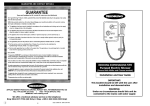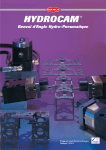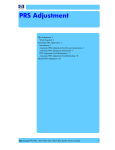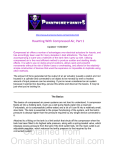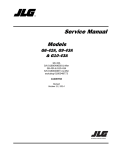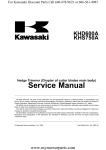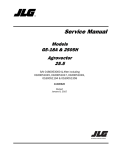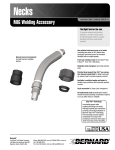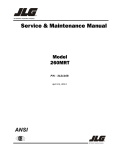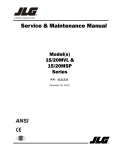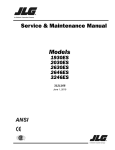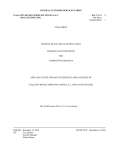Download hydrocam - Ready Technology
Transcript
READY HYDROCAM® System Serial No. ___________ It is important that this manual is read thoroughly prior to removing the HYDROCAM® system from its shipping container, begin installation in the tool or operating this product. READY Technology, Inc. 333 Progress Rd., Dayton, OH 45449 (800) 543-4355 • (937) 866-7200 fax (937) 866-7226 HYDROCAM is protected by USA and International Patents and Trademarks, and is a product of READY Technology, Inc. Copyright 2001 - 1998 READY Technology, Inc. All rights reserved. Installation and Service Manual HYDROCAM ® Index GENERAL DESCRIPTION..................................................... page 3 CAM SYSTEMS ................................................................. page 4 RECEIVING INFORMATION ............................................... page 4 H2 SELECTION CHART........................................................ page 5 H1 SELECTION CHART........................................................ page 6 PRE-INSTALLATION CHART ................................................ page 7 INSTALLATION ................................................................. page 9 INSTALLATION WARNINGS ................................................................ INSTALLATION PROCEDURE H1 PUMP'S, PISTON ROD DRIVER ........................................... INSTALLATION PROCEDURE PRE-ASSEMBLED HYDROCAM® SYSTEMS .................................. INSTALLATION PROCEDURE NON-ASSEMBLED HYDROCAM SYSTEMS, Nitrogen Return ....... REQUIRED POSITION OF H1 AS COMPARED TO H2 ................. HOSE CONNECTION H1 TO H2 ............................................. page 9 page 9 page 9 page 9 page 11 page 11 OPERATION ..................................................................... page 12 OPERATION - Nitrogen Return ............................................................. page 12 HAZARD WARNINGS ........................................................................ page 12 TROUBLESHOOTING TIPS ................................................................... page 13 OVERHAUL ...................................................................... page 15 DISASSEMBLY .................................................................................... page 15 CLEANING THE SYSTEM .................................................................... page 15 ASSEMBLY ......................................................................................... page 15 HYDROCAM® REBUILD ..................................................... page 16 H1 PUMP SEAL KIT INSTRUCTION ...................................................... page 16 H2 UNIT SEAL KIT INSTRUCTION ....................................................... page 18 MSDS (USA SYSTEMS ONLY) ...................................... Added to the back of this Manual HYDROCAM CATALOG...................................... Added to the back of this Manual 2 General Description HYDROCAM® transfers the vertical action of the press into a precise cam action using patented hydraulic technology. Standard components combine into systems, easing installation in the tool. The H2 Piercing/Forming unit can be provided with a machinable front plate that simplifies custom applications. HYDROCAM® action results from the lowering of the press ram/slide, to activate the H1 Pump’s piston rod. Hydraulic pressure or force is transferred through high pressure hose(s) to one or multiple H2 Piercing/Forming units, extending the H2 unit’s piston rod. The H2 unit has an adjustable return force using proven nitrogen technology. General Description HYDROCAM® systems incorporate patented products and processes that are reshaping the way metal stamping dies are designed and operated, leading to fewer dies required for part manufacture. HYDROCAM® is simple to design, install and operate. HYDROCAM® removes complexity from piercing/forming and replaces it with simplicity. H1 H2 NOTE: HYDROCAM®’s unique design eliminates the thrusting force of the ram/slide from the cam station, allowing the use of standard L-GIBS to position and guide the station. Providing a guidance system for a HYDROCAM® driven cam station is the responsibility of the customer. Neither, the H2 unit’s piston rod, nor its front mounting plate assembly is designed to provide cam station guidance. Contact your representative for application support. 3 Cam Systems Currently we offer two types of cam systems: CAMDRIVE® and HYDROCAM®. With both systems, we eliminate the need for bulky, complicated custom ® mechanical cams. With our standard HYDROCAM systems, you can achieve any angle of movement. In addition, the designer has greater flexibility in the component placement with any HYDROCAM® system. Hydraulic oil provides for the continuous performance and long life of the HYDROCAM® system. The oil automatically lubricates the cylinder wall on every stroke of the press, reducing friction on the H1 Pump and H2 unit's cylinder seals. Reduced friction increases seal life and decreases downtime. HYDROCAM’s® use of any premium ISO V-32 series hydraulic oil extends maintenance-free service, far superior to any other mechanical cam system on the market. With HYDROCAM®, there are no off-die tanks, hoses or safety problems that result from their use. Also, there is no wasted time required to assemble, dismantle, store and find tanks, valves, fittings and hoses. Important Receiving Information NOTE: Some HYDROCAM® systems are shipped pre-assembled with the hydraulic oil already added. With these systems, make sure that the H1Pump is kept upright at all times. Failure to do so may result in the loss of hydraulic oil. Check the contents of your shipment against the packing list! Make sure that all items are accounted for before discarding the container and packaging material. 4 Otherwise, field-assembled parts, accessories or requested spare parts could be discarded with the packaging material. In case of damage, advise the carrier who delivered the shipment. File a claim with that carrier immediately! Do not return damaged components for repair or replacement unless you have contacted your local branch or distributor for instructions and obtained a "Returned Goods" (R.G.) number. How To Select a HYDROCAM ® System for Your Application 1. Determine tonnage required (piercing or forming force, plus stripping force), per unit to perform the necessary work. Note when using urethane or other mechanical methods for stripping, please add the appropriate stripping force. 2. After you calculate the forces, select the correct H-2 unit(s) required to do the work. Do not exceed 90% of the H-2 unit’s available de-rated force (rated force, less return system force) from the chart below. Include the proper stroke length needed for each unit. 3. Determine the correct size and number of H-1 pump(s). Group identical H-2 units together (tonnage and stroke), performing identical work (piercing, forming of flanging). One H-1 pump can operate up to four identical H-2 piercing/forming units (see chart on page 6). Force of H2 Piercing/Forming Unit H-2 This chart shows the effect of a nitrogen or oil return system on the force rating of each H2 unit. Standard Rate equals the effect of standard (minimum) return force at 100 bar (1,450 psi) on the H2 unit’s force. Ideal for piercing applications that use a customer-provided stripper. Model Model Model Model Model Model Model 2 3.2 5 7.8 12.5 20 31 Std. Rate daN Metric tons 1,787 1.8 2,885 2.9 4,545 4.5 7,094 7 11,319 11.3 18,819 18.8 28,817 28.8 Std. Rate lbf. USA tons 3,932 2 6,346 3.2 10,002 5 15,611 7.8 24,906 12.5 41,440 20.7 63,439 31.7 daN Metric tons 1,698 1.7 2,728 2.7 4,319 4.3 6,740 6.7 10,742 10.7 18,230 18.2 27,727 27.7 lbf. USA tons 3,732 1.9 5,993 3 9,494 4.7 14,815 7.4 23,609 11.8 40,115 20 60,989 30 Max Rate Maximum Rate equals the effect of maximum return force at 150 bar (2,175 psi) on the H2 unit’s Max Rate force. Ideal for multiple piercing applications, special shape piercing, all forming and flanging. H1 and H2 Selection Guide Basic Selection: Working Example: To pierce two holes, 0.250 inch diameter, through 0.125 thick mild steel, with 50,000 psi minimum tensile strength. We selected a 25mm stroke length for this example. (The working example uses piercing as the HYDROCAM application. HYDROCAM is also ideal for forming, flanging and other applications.) Step 1 Calculate the force. Force = (Hole Ø X (π = 3.1416) X material thickness X material tensile strength) + recommended 10% stripping force English example: (.250 in. X 3.1416 X .125 in. X 50,000 psi) + 10% = 4,909 lbs. + 491 lbs. = 5400 lbs. (÷ 2000 lbs. = 2.7 U.S. tons) Metric example: (6mm X 3.1416 X 3mm X 40 daN per mm2) + 10% = 2,262 daN + 226 daN = 2,488 daN (÷ 1000 N = 2.5 metric tons) Step 2 Select the rate. In this example use the standard rate for Example Chart piercing. H-2 Step 3 Apply the Rule of Ninety: Never exceed 90% of the rated force. 5400 lbs. ÷ 0.90 = 6000 lbs. Step 4 Read across the above chart until the rated force exceeds your Rule of Ninety value. In this example 6,346 lbs. exceeds 6000 lbs. Step 5 Read up to the column heading. This is the H2 model you need. In this example, H2 model 3.2. Step 2 Model Model 2 3.2 Std. Rate daN Metric tons 1,787 1.8 2,885 2.9 Std. Rate lbf. USA tons 3,932 2 6,346 3.2 Max Rate daN Metric tons 1,698 1.7 2,728 2.7 Max Rate lbf. USA tons 3,732 1.9 5,993 3 Step 5 Step 4 FORCE WARRANTY: The minimum force that a H2 Piercing/Forming unit is warranted to provide is listed in the maximum rate column. If the customer's determined application force for a cam station’s tonnage exceeds 90% of the maximum rate force, the next larger or multiple H2 unit(s) must be selected. 5 HYDROCAM® H1 Pump Selection Chart This chart determines the appropriate H1 Pump for the H2 unit(s) selected. The chart also lists the H1 Pump’s piston rod travel (mm) next to the number of identical H2 units served. You need to know the H2 model number, the number of H2 units required and the H2 stroke length before using this chart. Always use the Rule of Ninety. The chart is based on using ninety percent of the total volume (VT) of the H1 Pumps listed, in determining the number of identical H2 units that can be supplied by an H1 pump. Different stroke lengths or different H2 models may not be used with the same H1 Pump. No more than four H2 units may operate off a single H1 Pump. When two or more identical H2 units are used to extend a gang pierce bar or forming pad, each H2 unit must have its own H1 Pump. NOTE: Piston rod travel may vary slightly. This results from normal variations in connecting hose length(s), and the number and style of the turning fittings. Use only approved hose and fittings. H-2 25 mm Model 2 50 mm Model 3.2 25 mm Model 2 50 mm Step 2 Step 1 25 mm Model 3.2 Model H-1 50 mm 5 Model 5 Model Model Model 13 20 40 66 1 (12.99) 2 (18.49) 3 (23.98) 4 (22.26) 25 mm 50 mm 1 (25.44) 1 (21.63) 25 mm Model 20 Model 31 Step 4 3 1 (19.55) 2 (31.60) 4 1 (25.57) 1 (25.57) 2 3 2 (26.48) 3 (35.96) 4 (22.79) (27.88) (22.79) 4 (25.59) (30.43) (23.55) 2 (22.35) 1 (37.17) 1 (20.05) 3 (29.77) 4 (37.19) 3 (40.90) 1 (26.32) 2 (29.77 4 (52.04) 3 (25.08) 1 (30.92) 2 (27.31) 4 (30.94) 50 mm 75 mm Model 12.5 3 (25.57) 4 (31.60) 1 (22.33) 2 (37.17) 3 (26.32) 4 (22.35) 25 mm Model 7.8 3 (29.64) 2 (22.26) 4 (37.02) 3 (21.74) 1 (26.48) 1 (26.48) 2 (23.55) 4 (26.49) 2 (21.74) 1 (35.96) 1 (19.54) 4 (35.99) 3 (28.86) 50 mm 75 mm 50 mm 1 (27.31) 2 (30.94) 3 (42.65) 75 mm 1 (25.08) 2 (42.65) 100mm 1 (30.94) 1 (30.94) 25 mm 50 mm 1 (23.52) 2 (26.45) 3 (35.93) 4 (45.41) 1 (26.45) 2 (45.41) 75 mm 1 (35.93) 1 (35.93) 100mm 1 (45.41) 25 mm 1 (22.29) 2 (37.08) 3 (51.87) 50 mm 1 (37.08) 75 mm 1 (51.87) 100mm special 1 (12.99) 2 (18.49) 3 (23.98) 1 1 2 1 (18.49) (16.47) (25.44) (25.44) Here is what you need to order: Step 3 Locate the H2 unit and its stroke. In this example: model 3.2, stoke 25mm. Step 3 Locate the number of H2 units to the right of the stroke length. The H1 Pump’s piston rod travel (in millimeters) is listed next to that number in parentheses. Step 4 Read up to the column heading. This is the H1 model you need. In this example: H1, model 5. 6 Model 8 1 (18.49) 1 (16.47) 2 (25.44) 25 mm 75 mm Step 1 and 2 Model 5 75 mm Working Example: H-2 Model H-1 QTY PRODUCT DESCRIPTION 2 H-2-3.2 Piercing unit with 25mm stroke and front plate 1 H-1-5 Pump with stroke gauge ring 1 RT-2175-CP Nitrogen Control Panel 2 RT701810670-6 Hydraulic Hose 6 foot long with swivel fittings (specify lengths up to 6 foot) 2 RT52041JC55-6 Nitrogen Hose 6 foot long with swivel fittings (specify lengths up to 6 foot) Note: • Nitrogen return is standard, oil return can be specified as an option. • Front plate is standard, direct punch can be specified as an option. • Straight fittings will be supplied to connect the hoses when ordered as a system, elbow fittings can be specified as an option. Pre-Installation Guide 1. Determine required cam station tonnage (piercing or forming force, plus total stripping force, plus nitrogen or oil return force). Do not exceed 90% of the H2 unit’s rated force (listed force, less return system force). See page 5. 2. Determine the number of H2 unit's needed for that tool’s applications. 3. Select the H2 unit's stroke from those offered. A longer stroke could require a larger H2 unit. 4. Group identical H2 unit’s together (tonnage and stroke). Group identical cam actions together (number, size or shape piercing units, forming, flanging, notching). 5. Determine timing for the extension, dwell and retracting of the H2 unit's piston rod. 6. Ball Lock Punch applications; Select a 50 mm or longer stroke H2 unit to provide additional space to remove the punch. Selecting the Mounting Location for the H2 Piercing/Forming Unit(s). 1. Locate the H2 unit(s) in any three dimensional orientation, perpendicular to the work. 2. Provide for hose access to the back and right front side of the H2 unit. Custom porting is not available. 3. Provide a mounting platform that will support three times the total working force of the H2 unit. Locate the H2 unit against a thrust key. 4. The H2 unit is designed to provide force, not guidance. 2. Select an H1 Pump that provides the H2 unit's volume total within 90% of the H1 Pump's total volume. Do not exceed 90%. See page 6. 3. The stroke gauge ring can be provided with the H1 Pump to develop the customer-supplied driver (kiss block) thickness and to ensure precise travel of the H1 Pump’s piston rod. Note: Machining tolerances may cause the mounting surfaces of the H1Pump and/or driver to differ from the drawings. Determine the driver thickness from the finished surfaces, not the drawings. Pre-Installation Selecting the Correct H2 Piercing/Forming Unit 4. One H1 Pump may serve up to a maximum of four identical H2 units. Selecting the Mounting Location for the H1 Pump 1. The H1 Pump's piston rod must be up and perpendicular to the ram/slide. Do not mount the H1 Pump in an inclined press or an inclined special machine. 2. Locate the H1 Pump’s oil supply ports above the H2 unit’s vent port elevation. See page 11. 3. Locate the H1 Pump anywhere in the die, under the ram/slide, that provides balance and simple hose access to the H2 unit(s). Avoid areas using spray lubrication. 4. Locate the H1 Pump within 2 meters (six feet) of the H2 unit(s). 5. Rotate the H1 Pump prior to mounting to ensure access and viewing of the Pump’s sight gauge. NOTE: As with any air, hydraulic or nitrogen cylinder, neither the H1 Pump nor the H2 unit is designed to withstand side-thrust forces. Properly guiding the tool and cam station minimize wear to the cylinders and increase seal life. 5. The H2 unit’s Piston Rod is designed to extend fully. NOTE: HYDROCAM®’s unique design eliminates the thrusting force of the ram/slide from the cam station, allowing the use of standard L-GIBS to position and guide the station. Providing a guidance system for a HYDROCAM® driven cam station is the responsibility of the customer. Neither, the H2 unit’s piston rod, nor its front mounting plate assembly is designed to provide cam station guidance. Contact your representative for application support. Selecting the Correct H1 Pump 1. The H1 Pump is selected by using the information developed while selecting the H2 unit(s). (See calculation pages in the HYDROCAM® catalogue.) See page 5. Special Timing of the H2 Unit’s Piston Rod Extension, Dwell and Retraction. Request the help of your representative to select a; 1. Larger H1 Pump to begin cam extension later in the stroke. 2. Nitrogen cushion to begin cam extension earlier in the stroke. 3. Sequenced Solenoid Technology (SST) for special timing requirements. 7 Pre-Installation (continued) Nitrogen Return System 4. Hydraulic or air cylinder, pressure system for special machine applications. 1. Always use a control panel. 2. For each H1 Pump, use at least one control panel that connects that H1’s associated H2 units. Connecting the H1 Pump, H2 Piercing/Forming Unit(s) and Nitrogen Return Control Panel. See page 11. 3. Use O-ring style hose fittings. Note: We understand that a few applications will exceed this guide. Contact your representative for application support. 1. Minimize the number of fittings in the hose system. 2. Do not use a hose system that involves a fitting - to fitting - to fitting series of connections. 3. Hose each identical H2 unit to a H1 Pump with its own hose. Do not hose in series. Provide simple access for hose routing. Use only approved hose and fittings. H1 Pump Driver (not supplied) 4. Provide additional hose length to ensure appropriate radius and safe routing. Avoid high spots in the oil hose route that will trap and create air pockets. Piston Stroke Gauge Ring 5. Maximum hose length is 2 meters (six feet). Do not substitute the supplied hydraulic hose with a smaller or lighter duty hose. Fill Port Exhaust Valve 6. Rotating the H1 Pump 45° may simplify hose routing. 7. Avoid turning fittings. If a hose turn requires a turning fitting, select a 45° fitting as a first choice and a 90° fitting second. Use only BSPP-style fittings. Body Sight Gauge H1 Oil Level (4) Oil Supply Ports Base H2 Unit Vent Plug Oil Supply Port Piston Nitrogen Inlet Port Anti-rotational Pillars H2 Thrust Key (not supplied) 8 Body Bronze Bushing Side View Front Mounting Plate Front View Front Mounting Plate (plate is machinable) Installation PROVIDING A GUIDANCE SYSTEM FOR THE PIERCING OR FORMING STATION IS THE RESPONSIBILITY OF THE CUSTOMER. NEITHER THE H2 PIERCING/FORMING UNIT'S PISTON ROD NOR ITS FRONT MOUNTING PLATE ASSEMBLY IS DESIGNED TO PROVIDE CAM GUIDANCE. Installation Warnings 1. HYDROCAM’s® H1 Pump must be set in the die or press in a vertical position with the piston rod up and perpendicular to a horizontal ram/slide. ® 2. Never stroke a HYDROCAM system unless all components are properly mounted and nitrogen is added to the return system. ® 3. HYDROCAM’s H1 Pump must be set above the elevation of H2 Piercing/Forming unit(s). See page 10. 4. The tool must include stop blocks to prevent over-travel of the HYDROCAM’s® H1 Pump's piston rod. 5. Never store the tool in a die closed position or depress the piston rod of the HYDROCAM’s® H1 Pump(s) during storage. 6. Never loosen a hose fitting if the return system is under nitrogen pressure or the H2 unit's piston rod is extended. Installation Procedure H1 Pump's Piston Rod Driver The H1 Pump's piston rod travel is critical to the successful operation of the HYDROCAM® system. 1. Machine smooth and parallel, the tool’s mounting surfaces for the H1 Pump (lower) and the customer-supplied driver (upper). The diameter of the driver's contact surface is a minimum of twice the diameter of the H1 Pump's piston rod. This contact surface must be smooth and parallel with no mounted holes. Use a Rockwell 45C plate for the driver. 2a. If the H1 Pump’s, stroke gauge ring is available, mount and use it to develop the travel of the H1 Pump's piston rod. The measurement from the base of the H1 Pump, to the top of the mounted stroke gauge ring determines the die-closed position of the customersupplied driver’s contact surface. Use this measurement to calculate the length of the customer-supplier driver. We recommend that the stroke gauge ring be removed and stored on the tool prior to stroking the H1Pump. OR ... 2b. Use the formula (Calculating the H1 Piston Rod ® Travel) from the HYDROCAM catalogue to determine the length of the H1 Pump's piston rod travel. See page 6 for the H1 selection and travel of piston. The measured height from the base of the H1 Pump, to the top of the piston rod extended, less the calculated piston rod travel, locates the die closed position of the contact surface of the customer-supplied driver. Use this measurement to calculate the length of the driver. Installation Before attempting to install or service, READ THIS MANUAL THOROUGHLY. Installation Procedure - Pre-Assembled HYDROCAM® Systems Installation of a PRE-ASSEMBLED SYSTEM is the same as the procedure for installing a NON-ASSEMBLED SYSTEM. Begin at step 2. of that section, noting that the hydraulic oil has previously been added to the system. With the nitrogen pressure fully discharged, the H2 unit's piston rod may be extended by carefully depressing the H1 Pump's piston rod with a manual press. Installation Procedure - Non-Assembled HYDROCAM® Systems, Nitrogen Return 1. Check to see that the system's H1 Pump, H2 Piercing/Forming unit(s), hose assemblies and system accessories are not pre-assembled (see above). 2. Locate the H2 unit in the desired position. The part number RTAUX-1000 Hand/Fill pump can be connected to the H2 unit's hydraulic oil port to move the piston rod, easing the alignment of the customerprovided piercing or forming station and guidance system. Locate the H2 unit against a thrust key. 3. When alignments are correct, set and tighten four mounting bolts and two dowels in the holes provided on the H2 unit. Follow the same procedure for each additional H2 unit. Note: If access to the H2 unit is limited, final mounting can wait until after hydraulic oil has been added to the system. 4. Locate the H1 Pump in the desired position, then set and tighten four mounting bolts. The H1 Pump must be located at a higher elevation than the H2 unit. Note: If access to the H1 Pump is limited, final mounting may wait until after hydraulic oil has been added to the system. Rotate the H1 Pump prior to mounting to ensure access and viewing of the Pump’s sight gauge. See page 11. 9 Installation (continued) 5. Connect the H1 Pump and the H2 unit(s) with hose and fittings, providing additional hose length to assure appropriate radius and safe routing. Do not allow high spots in the hose routing. Use Blue lock-titeTM on all threads and tie-downs on the hose(s). 6. With the H2 unit's piston rod in the full-back (die-open) position, slowly charge the H2 unit(s) with 100 bar (1450 psi) of nitrogen using the control panel or the RTUAL-04.0-QDM service tool. To install the control panel, the cover plug and inlet valve must be removed before installing the adapter fitting on the front (bronze) bushing of the H2 unit(s). 7. Adding ISO V-32 Series Hydraulic Oil to the System: A. To prevent contamination from entering the hydraulic system, loosen the fill port plug on top of the H1 Pump, but do not fully remove it. Then, loosen the vent port plug on top of the associated H2 unit(s), but do not fully remove it. Remove the plugs only when hydraulic oil is being added or air is being bled. Depending on the location of the H1 Pump and its H2 unit(s), two people may be needed to complete the following tasks. B. With a squeeze bottle or the RTAUX-1000 Hand/Fill pump, fill the system slowly with the hydraulic oil, through the fill port on top of the H1 Pump. While one person is adding the hydraulic oil, the other will open fully, the lowest mounted H2 units’ vent port until a continuous flow of pure hydraulic oil (no air bubbles) flows from the vent port, then replace the port plug. Repeat the same with any additional H2 units(s), moving from the lowest to the highest mounted. After all H2 vent plugs are in place, add hydraulic oil until it centers in the H1 Pump’s sight gauge. Do not over-fill the system with hydraulic oil. C. Beginning with the lowest mounted, separately and carefully, reopen the vent ports on each H2 unit. Let it open until no air bubbles rise out of the vent port. If the hose assembly was properly laid-out, subsequent to adding hydraulic oil, all air bubbles are now out of the system. If care was not taken to ensure the smooth fall and rise of the hose assembly, the hose system must be adjusted and the process repeated. D. Check the H1 Pump’s sign gauge and add hydraulic oil, if needed. Do not overfill the H1 Pump. Center the hydraulic oil in the sight gauge, replace and tighten the H1 fill port plug. 10 E. Check alignments and check to be certain all fittings are tightened. 8. Stroke the H1 Pump three times, ensuring that the H2 unit’s piston rod fully extends, and at the die open position, the hydraulic oil level is centered in the H1 Pump's sight gauge. Also, check that the H2 unit's piston rod returns to its full-back (die open) position. Add additional hydraulic oil, if need, as stated in step 7. Your hydrocam system is now ready for production. HYDROCAM systems with the H2-2 unit(s) or systems with very long Hydraulic Drive Hose Assemblies can be more difficult to fill. The following will assist: a. First, discharge the nitrogen return system. With a pry bar, carefully cause the front mounting plate to move it forward about 3 mm (1/8”). It is not necessary, nor recommended that the front mounting plate be moved open any farther. b. Complete Steps A-D listed above, understanding that these systems will take longer to fill. Setting the H1 Pump much higher than the H2 unit(s) while adding hydraulic oil to the system will aid in filling these systems. After completing Step D above, return and complete Step c, listed below. c. With the H1 Pump’s fill port open, push the H2 unit’s front mounting plate(s) back into the full-back (die open) position. Next, charge the nitrogen return system. With the H2 unit’s front mounting plate(s) fullback, check the oil level in the H1 Pump’s sight gauge. The oil level may be too high. Drain excess oil from the system. Complete Step E listed above. Complete assistance is available should the need arise. contact your representative for details. THE MOST COMMON HYDROCAM® OPERATING PROBLEM IS AIR CAUGHT IN THE HOSE SYSTEM. ENSURE THAT YOU HAVE PROPERLY MOUNTED THE H1 PUMP, AVOIDED HIGH SPOTS IN THE HOSE SYSTEM AND BLED THE SYSTEM OF AIR. Installation (continued) MODEL HYDROCAM HYDROCAM HYDROCAM HYDROCAM HYDROCAM HYDROCAM Sight Gauge Nitrogen Inlet Port NOTE: We understand that a few applications will exceed this guide. Contact your representative for application support. H1-5 H1-8 H1-13 H1-20 H1-40 H1-66 H DIMENSION 21 mm (0.83 in) 25 mm (0.98 in) 25 mm (0.98 in) 25 mm (0.98 in) 30 mm (1.18 in) 40 mm (1.57 in) Installation/Operation Required position of H1 as compared to H2 Hose Connection H1 to H2 Wrong Right NOTES: 11 Operation ® Standard HYDROCAM systems operate using a simple hydraulic driven extension with a nitrogen return and require no special conditions or procedures to operate them. Ensure that the PRE-INSTALLATION GUIDE and INSTALLATION sections of this manual have been followed prior to operation. During normal operation, occasionally inspect the hydraulic oil level by viewing the sight gauge on the H1 Pump’s body. The oil level should be centered in the sight gauge. In addition, check the nitrogen pressure 100 bar (1450 psi) in the H2 Piercing/Forming unit's front (bronze) bushing on the control panel or with the RTUAL04.0-QDM service tool. (Note: The installation of the RTUAL-04.0-QDM service tool will automatically lower the nitrogen pressure in the H2 unit as the nitrogen fills the additional volume in the service tool.) As with any air, hydraulic or nitrogen cylinder, neither the H1 Pump nor the H2 unit is designed to withstand side-thrust forces. Properly guiding the tool and cam station will limit damage to the cylinders and increase seal life. ® THE MOST COMMON CAUSE OF A HYDROCAM SYSTEM NOT OPERATING IS AIR CAUGHT IN THE HOSE SYSTEM. ENSURE THAT YOU HAVE PROPERLY MOUNTED THE H1 PUMP, AVOIDED HIGH SPOTS IN THE HOSE SYSTEM AND BLED THE SYSTEM OF AIR. Complete engineering assistance, seminars and service support are available should a need arise for any of our full line of metal forming products. Contact your representative for details. Hazard Warnings • ONLY PERSONNEL WITH THOROUGH KNOWLEDGE OF HYDRAULIC AND/OR NITROGEN CYLINDER SYSTEMS SHOULD ATTEMPT TO SERVICE OR REPAIR THIS SYSTEM. • BEFORE ATTEMPTING TO CHARGE OR EXHAUST THIS OR ANY SYSTEM USING HIGH PRESSURE NITROGEN, HYDRAULICS, OR USE OTHER EQUIPMENT CONTROLLING OR STORING ANY COMPRESSED GAS. ALWAYS USE APPROVED EYE AND EAR PROTECTION. • SLOWLY EXHAUST ALL NITROGEN FROM THIS SYSTEM BEFORE SERVICING. MAKE SURE ALL PRESSURE HAS BEEN COMPLETELY EXHAUSTED BEFORE ATTEMPTING TO REMOVE ANY FITTINGS, HOSES, H1 PUMP, H2 PIERCING/FORMING UNIT(S), CONTROL PANEL OR OTHER COMPONENTS. 12 •EXCEPT FOR AN EMERGENCY, ALWAYS SLOWLY CHARGE OR EXHAUST THIS OR ANY NITROGEN SYSTEM. RAPIDLY CHARGING OR EXHAUSTING A NITROGEN SYSTEM COULD RESULT IN DAMAGE TO EQUIPMENT AND/OR INJURY TO PERSONNEL. • DO NOT SUBSTITUTE ANY COMPONENT IN THIS SYSTEM! IMPROPER SUBSTITUTIONS MAY RESULT IN PERFORMANCE PROBLEMS AND/OR SAFETY HAZARDS. • DO NOT ATTEMPT TO REUSE ANY COMPONENT THAT IS, OR APPEARS TO BE DAMAGED. THIS CAN RESULT IN POTENTIAL PERFORMANCE PROBLEMS AND/OR SAFETY HAZARDS. • USE ONLY A PREMIUM ISO V-32 SERIES HYDRAULIC OIL. Troubleshooting Tips NOTE: (***) Indicates repair of the component is in question. HYDROCAM® components must be replaced with an exact duplicate part. Failure to do so may result in serious injury, as well as cause damage to the HYDROCAM® system or tool. PROBLEM: H2 Unit’s Piston Rod is not Extending to its Full Stroke. CAUSE: There is air in the hose system. Air has not been bled from the system. There is a high spot in the hose system trapping air. The H1 Pump is not mounted above the H2 unit(s). Adjust and bleed the air from the system. See pages 10 and 11. CAUSE: The H1 Pump is undersized. Volume Total of the H2 unit(s) is greater than 90% of the H1’s Total Volume. See page 6. CAUSE: The H1 Pump’s piston rod has been continuously over-stroked, weakening the safety relief valve. Contact your representative! PROBLEM: H2 Unit’s Piston Rod is not Returning to its Full-Back (Die-Open) Position. CAUSE: The cam station does not have a guidance system causing the station to bind the H2 unit’s piston rod. Install a cam station guidance system. The H2 unit is designed to provide force not guidance! See page 7. CAUSE: Multiple H2 units are hosed in series. Re-hose using a single hose from each H2 unit to its own H1 Pump port. An excessive number of fittings have been used. Eliminate or reduce the number of turning fittings. The supplied hose was substituted with a smaller ID hose. Use only approved hose and fittings. CAUSE: Check the nitrogen pressure, 100 bar (1,450 psi). If the nitrogen pressure is low, charge the system to 100 bar (1,450 psi) and check for nitrogen leaks in the system. If nitrogen pressure is very low and/or frequent charging is required. Rebuild the H2 unit with the appropriate seal kit.*** If the H2 unit is self-contained and the inlet valve is leaking, replace it with new.*** If the nitrogen pressure is 100 bar (1,450 psi), check the H1 Pump (see below). CAUSE: The H1 Pump’s hydraulic oil level is not correct. The oil level should be centered in the H1 Pump's sight gauge, add or remove excess oil and bleed air from system. CAUSE: The H1 Pump's hydraulic oil level is too high. The oil level should be centered in the H1 Pump's sight gauge. Remove excess oil and bleed air from the system. CAUSE: The H1 Pump's piston rod is not being travelled the correct distance. Recheck using the stroke gauge ring that the H1 Pump’s piston rod travel is correct. Adjust (lengthen or shorten) the H1Pump's piston rod travel. Contact your representative for support. See page 6. CAUSE: There is an internal nitrogen leak in the H2 unit causing the hydraulic oil in the system to foam. Rebuild the H2 unit. CAUSE: The H2 unit is undersized for this application. Check that the required force (piercing or forming force + stripping force + return force) is not beyond 90% of the maximum rated tonnage capacity of H2 unit. See page 5. Hazard Warnings/Troubleshooting Tips THE MOST COMMON CAUSE OF A HYDROCAM® SYSTEM NOT OPERATING IS AIR CAUGHT IN THE HOSE SYSTEM. ENSURE THAT YOU HAVE PROPERLY MOUNTED THE H1 PUMP, AVOIDED HIGH SPOTS IN THE HOSE SYSTEM AND BLED THE SYSTEM OF AIR. PROBLEM: H1 Pump's Piston Rod is not Returning to a Full-Up (Die-Open) Position. CAUSE: The H1 Pump's hydraulic oil level is too high. The oil level should be centered in the H1 Pump's sight gauge. Remove excess oil and bleed air from the system. CAUSE: H1 Pump's piston rod is being over-travelled causing the 400 bar (5,802 psi) safety relief valve to activate on each stroke, resulting in hydraulic oil not returning back into the H1Pump's lower chamber. With the stroke gauge ring, adjust (shorten) the H1 Pump's piston rod travel and bleed air from the system. See page 6. 13 Troubleshooting Tips (continued) CAUSE: Hydraulic oil has filled the H1 Pump's upper chamber because the tool was stored in a die-closed position. See Installation Warnings, page 9. Carefully remove the fill port plug and exhaust valve on top of the H1 Pump using a 5mm hex wrench and an 11mm thinwall socket wrench, then slowly pull the piston rod up using a dowel puller (M8 for a H1-5 Pump, M10 for the H1-8 and H1-13 Pumps, M16 for a H1-20 Pump, M20 for the H1-40 and H1-66 Pumps). Check that the hydraulic oil level is centered in the H1 Pump's sight gauge. Replace and tighten the fill port plug and exhaust valve. CAUSE: Hydraulic oil is by-passing the H1 Pump base's green O-ring seal. Rebuild the H1Pump. *** See page 16. CAUSE: The H1 Pump's piston rod return spring is weak, damaged or undersized. Replace with a new, unpainted return spring. *** CAUSE: If the H2 is self-contained and the inlet value is leaking, replace it with new. Note: Nitrogen return systems that use a control panel do not have an inlet valve in the H2 unit! CAUSE: Nitrogen fitting(s) is leaking or breaking. The hose fitting(s) was never tightened or over-tightened during assembly. Replace any leaking hose or fitting with new. Use O-ring style hose fittings. Use Blue locktiteTM on all threads and tie-downs on the hose(s). An excessive number of fittings have been used. Eliminate or reduce the number of fittings. Use only approved hose and fittings. CAUSE: Scratched H2 unit piston rod, damaged and/or leaking components, seals, hoses, fittings or components on the control panel. Follow standard leak tests to determine location of the leak. Replace any damaged or leaking part with new. H2 unit was rebuilt using the wrong or damaged seal kit components. *** System is in need of general overhaul. *** PROBLEM: Loss of Hydraulic Oil. PROBLEM: Rupture Plug Failure. CAUSE: Hydraulic oil was accidentally drained. The oil level should be centered in the H1 Pump's sight gauge, add oil and bleed air from system. CAUSE: Hydraulic oil fitting(s) is leaking or breaking. The hose fitting(s) was never tightened or over-tightened during assembly. Replace any leaking hose or fitting with new. Use Blue lock-titeTM on all threads and tie-downs on the hose(s). An excessive number of fittings have been used. Eliminate or reduce the number of turning fittings. Use only approved hose and fittings. CAUSE: Scratched H1 or H2 piston rod, damaged components, seals, hoses or fittings are causing a leak. Follow standard leak tests to determine the location of leak. H1 Pump or H2 unit rebuilt using the wrong or damaged seal kit components causing leaks. *** PROBLEM: Loss of Nitrogen Pressure. CAUSE: Nitrogen pressure is low, resulting from the normal loss following the installation of the RTUAL-04.0QDM service tool. Recharge system. 14 CAUSE: Nitrogen pressure was accidentally reduced. Recharge system. CAUSE: Nitrogen pressure charged too high, maximum pressure is 150 bar (2175 psi). A hose has been crushed or has too tight a radius. Defective, weakened or incorrect rupture plug. *** Die lubricant has entered the system (see below). Eliminate source and rebuild system. PROBLEM: Hydraulic Oil Level in H1 Sight Gauge Appears to be Rising. CAUSE: Die lubricant is entering the system through the H1 Pump or H2 unit(s). Eliminate source of the die lubricant and rebuild system. PROBLEM: The Nitrogen Charge Pressure Indicator on the Control Panel does not rise when the ram/slide is set at Die-Closed Position. CAUSE: The Inlet valve was not removed from the H2 unit during installation of the nitrogen return system's hose assembly. Using the RTUAL-04.0-QDM service tool, exhaust all nitrogen from the H2 unit and remove the inlet valve. Overhaul Disassembly 1. WITH THE CONTROL PANEL OR THE RTUAL-04.0QDM SERVICE TOOL, SLOWLY EXHAUST ALL NITROGEN FROM THE SYSTEM BEFORE SERVICING OR HANDLING. ENSURE COMPLETE DISCHARGE OF PRESSURE BEFORE ATTEMPTING TO REMOVE ANY H1 PUMP, H2 UNIT(S), CONTROL PANEL, HOSES, FITTINGS, OR ANY OTHER SYSTEM COMPONENTS. ® 2. To begin disassembly of the HYDROCAM system, locate and remove hydraulic oil hose fittings and port plug(s) from the H1 Pump and H2 unit(s). Drain the hydraulic oil completely out of the system. CAUTION: Do not allow the hydraulic oil to drain on to the floor, as it is extremely slippery. Do not reuse the hydraulic oil, as it may be contaminated. Consult the MSDS form for the ISO V-32 series hydraulic oil that you are using for additional handling information. For cylinder disassembly refer to the instructions included in this manual, see H1 Pump or H2 unit's seal kit section, pages 16 and 18. guidelines to reinstall a HYDROCAM® system. Prior to installation, make sure that all seals, sealing surfaces and O-rings are lubricated. Leave the two H1 Pump valves on top of the pump body loose so that ISO V-32 series hydraulic oil can be added to the Pump. Failure to follow the INSTALLATION section will result in ® damage to the HYDROCAM system. 3. The H1 Pump was designed to operate in a very specific orientation (vertical). To avoid loss of hydraulic oil, damage to equipment and/or injury to personnel, ® never operate this HYDROCAM component in any other position. 4. Use only a premium ISO V-32 series hydraulic oil. Substitution can cause performance problems and/or safety hazards. Troubleshooting/Overhaul Before attempting any service, read the sections on INSTALLATION and HAZARD WARNINGS and THIS MANUAL THOROUGHLY. 5. Prior to operation, follow standard leak tests to determine if there is any nitrogen or hydraulic oil leaks. ® 6. Never stroke a HYDROCAM system until all components are properly mounted and tightened. NOTES: Cleaning the System 1. Always remove all plugs, fittings and accessories before cleaning the components. Using solvent, thoroughly clean the disassembled H1 Pump, H2 unit(s) and system components. Carefully blow-dry the components with filtered compressed air. Inspect them for wear as described in the seal kit instructions. If in doubt, replace a worn component rather than have a premature failure in a newly rebuilt system. 2. When one major part of the system needs to be rebuilt, rebuild them all, to assure maximum service life and minimum downtime. Assembly 1. Rebuild the H1 Pump and H2 unit(s) according to the instructions included in this manual. See the H1 Pump or H2 unit’s seal kit section, pages 16 and 18. 2. Refer to the PRE-INSTALLATION GUIDE and INSTALLATION sections in this manual for proper 15 ® HYDROCAM Rebuild H1 Pump Seal Kit Instruction 3 BEFORE ATTEMPTING TO SERVICE OR REPAIR A HYDROCAM® SYSTEM, READ THE INSTALLATION AND SERVICE MANUAL THOROUGHLY. PLACING SPECIAL ATTENTION TOWARD THE HAZARD AND SAFETY WARNINGS LOCATED THROUGHOUT THE MANUAL. IF YOU DO NOT HAVE THIS MANUAL, CONTACT YOUR REPRESENTATIVE. Before disassembly of the H1 Pump, verify that the correct seal kit is on-hand and that it is complete. Thoroughly review the instruction and drawings included with this seal kit. 1. Disconnect the hose fitting(s) and/or port plug(s) attached to the four pump base sides. Using an 11mm thin-wall socket wrench and a 5mm hex wrench, remove the exhaust valve and fill port plug on top of the pump body. Empty the remaining hydraulic oil. 4 2. After carefully removing the sight gauge, use a pin spanner wrench to unscrew the pump body from the pump base. If a strap wrench is used, place it very close to the top of the pump body. Placing a strap wrench close to the pump base will exert greater force on the threads making removal difficult. 3. Carefully guide the piston rod out the bottom of the pump body. Taking care not to damage the piston rod or the pump body bore. 4. Note the colour, size, orientation and location of each seal. Remove all seals from the pump body and pump base, taking care not to damage the sealing surfaces. 5. High-pressure wash or solvent-clean the components that will be reused. Carefully blow-dry the components with filtered compressed air. Visually inspect the piston rod, pump body and pump base sealing surfaces. Replace any part that is damaged, worn, scratched or contains imperfections. 5 16 6. Carefully install the new seals in their proper location and orientation. Make sure that all seals, O-rings and sealing surfaces are lubricated before installation. ® HYDROCAM H1 Pump Rebuild (continued) Rebuild 7. Lubricate with oil and carefully guide the piston rod fully into the pump body. Install the unpainted return spring in the base of the piston rod and install the pump body assembly on the pump base and tighten firmly. Install the two H1 Pump valves on top of the pump body loosely, so that hydraulic oil can be added during tool installation. Carefully install the sight gauge. 8. Refer to the PRE-INSTALLATION GUIDE, INSTALLATION and OVERHAUL sections of the INSTALLATION AND SERVICE MANUAL for proper guidelines to reinstall this ® HYDROCAM component. Failure to follow those guidelines will result in performance problems, damage to the HYDROCAM® system, equipment and/or injury to personnel. H1 Pump 17 ® HYDROCAM Rebuild H2 Piercing/Forming Unit Seal Kit Instruction 1 BEFORE ATTEMPTING TO SERVICE OR REPAIR A HYDROCAM® SYSTEM, READ THE INSTALLATION AND SERVICE MANUAL THOROUGHLY, PLACING SPECIAL ATTENTION TOWARD THE HAZARD AND SAFETY WARNINGS LOCATED THROUGHOUT THE MANUAL. IF YOU DO NOT HAVE THIS MANUAL CONTACT YOUR REPRESENTATIVE. Before disassembly of the H2 unit(s), verify that the correct seal kit is on-hand and that it is complete. Thoroughly review the instruction and drawings included with this seal kit. 2 1. Completely discharge the nitrogen from return system using the control panel or the RTUAL-04.0-QDM service tool. If using a control panel with a nitrogen return system remove from the H2 unit's seal kit, the inlet valve and discard it. 2. Disconnect the hose fitting(s) and vent plugs attached to the H2 Body and front (bronze) bushing. Remove the front plate with its columns by removing the metric socket cap screw centered on the front plate. 3. Remove the four metric socket cap screws on the front of the (bronze) bushing and carefully separate the front bushing from the body. Take care not to damage the piston rod or sealing surfaces while the body, front bushing and piston rod are separated. 3 4. Note the colour, size, orientation and location of each seal. Remove the seals from the piston rod, body and front bushing, taking care not to damage the sealing surfaces. 5. High-pressure wash or solvent-clean the components that will be reused. Carefully blow-dry the components with filtered compressed air. Visually inspect the piston rod, body and front bushing sealing surfaces. Replace any part that is damaged, worn, scratched or contains imperfections. 6a 18 6. Carefully install the new seals from the seal kit in their proper location and orientation. Check to see that all seals, guide rings, O-rings and sealing surfaces are lubricated before installation. Place the front U-cup seal in the front (top) of the front bushing's seal chamber. Place grease on the U-cup seal, leaving the lower portion of the seal chamber open. ® HYDROCAM H2 Unit Rebuild (continued) 6b Rebuild PISTON ROD SEAL INSTALLATION TIP: Immerse the U-cup seals to be installed on the piston rod in hot hydraulic oil for several minutes prior to placing them on the piston rod. This will simplify the expansion of the U-cup seal as it slides onto the piston rod and into its seal chamber. (Note: Check that the orientation of the U-cup seal is correct prior to placing it on the piston rod. The two U-cup seals sit on either side of the piston guide ring and must be in opposing directions.) 7. Lubricate with oil and carefully guide the piston rod into the front bushing and install the bushing assembly in the base. Install the four metric socket cap screws in the front of the bushing, then install the front plate with its columns. Align the columns by indicating them parallel to each other. Recheck the parallelism of the columns prior to torquing the metric socket cap screws on the front bushing and centered on the front plate. Use blue Lock-tite™ on all threads. 8. If the H2 unit is using a self-contained nitrogen return and charged using the RTUAL-04.0-QDM service tool or using the optional oil return system, install a new inlet valve in the front bushing's nitrogen port. Do not install an inlet valve if the H2 unit will be used with a nitrogen return control panel. 7 9. Refer to the PRE-INSTALLATION GUIDE, INSTALLATION and OVERHAUL sections of the INSTALLATION AND SERVICE MANUAL for proper guidelines to reinstall this HYDROCAM® component in the tool or press. Failure to follow those guidelines will result in performance problems, damage to the HYDROCAM® system, equipment and/or injury to personnel 8 H2 Unit Venting Plug Piston Guide Ring Front U-cup Seal - nitrogen H2 Body (steel) Front Bush Body Seal Bush U-cup Seal - nitrogen Rod Scraper Seal Oil Port Piston Plug Rear U-cup Seal - oil Front Bush bronze) Piston 19 READY All Our Products Are Available Globally Our factories and offices: U.S.A. • Mexico • U.K. • France • Belgium • Germany • Sweden • Netherlands • Singapore READY TECHNOLOGY, Inc. 333 Progress Rd. • Dayton, OH 45449 (800) 543-4355 • (937) 866-7200 • FAX: (937) 866-7226 © 2001 READY TECHNOLOGY, INC. CATALOG # 1101





















